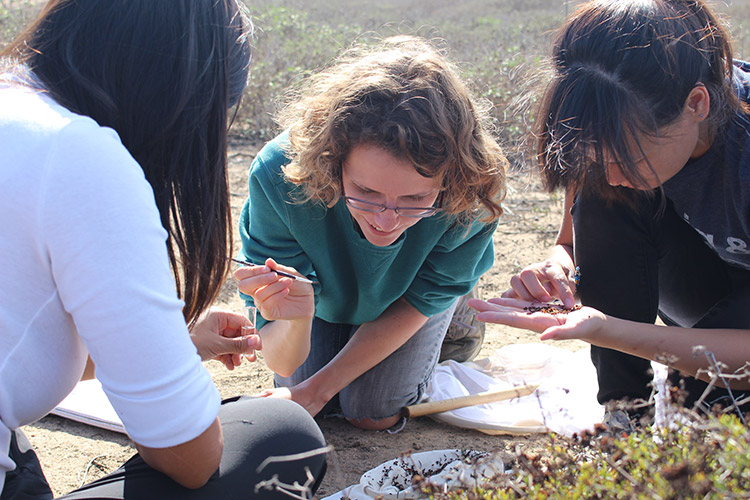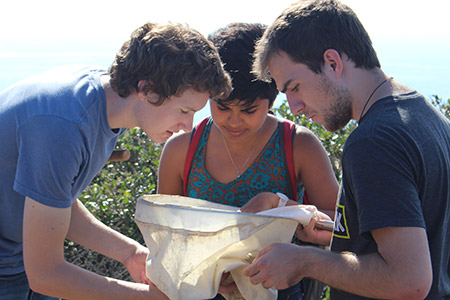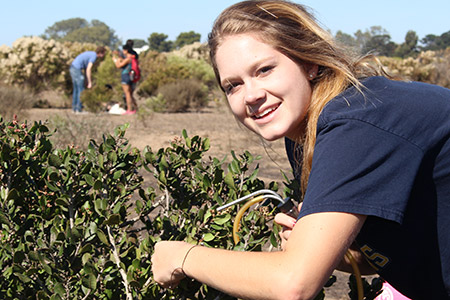By:
- Paul K. Mueller
Published Date
By:
- Paul K. Mueller
Share This:

Combing the Scripps Coastal Preserve near campus, students find and classify bugs for the Barcode of Life Database, one of the research projects of the San Diego Biodiversity Project. Photos by Heather Henter
Barcodes for Bugs: Biology Students Build Databases of Biodiversity
If, when strolling through the coastal sage atop the Scripps Coastal Reserve just west of campus, you come across students peering closely into the foliage, consider yourself fortunate to witness some very basic science – and very important biology – in the making.
As Heather Henter explains, these students are contributing to the Barcode of Life Database, one of the research efforts of the San Diego Biodiversity Project funded by the National Science Foundation. The genetic information in the bugs and other beasts the students find is collected and classified and made available to scientists everywhere.
“Rather than performing some rote experiment that thousands of other students have done over the years,” says Henter, an Academic Coordinator working for the Natural Reserve System, “these students are actively adding to the sum of our knowledge of the world.”

As students quickly learn, the Coastal Preserve contains a surprising number of bugs and other species, which they help categorize for science.
The students, some of whom participated in a recent outing to the Coastal Reserve to collect specimens, seem to appreciate the special nature of the protected land they help study. The University of California oversees 39 Natural Reserves, with four of them supervised by the Office of Research Affairs at UC San Diego.
“It’s the largest university-administered reserve system in the world,” says Henter. “It serves scientists and students by providing natural areas for research and education, and the people of California through wise stewardship of our public-trust lands.”
Along with the Scripps Coastal Reserve, UC San Diego also oversees the Kendall-Frost Mission Bay Marsh Reserve, the Elliott Chaparral Reserve, and the Dawson Los Monos Canyon Reserve, which features one of the few perennial freshwater streams in Southern California, Henter notes.
The Scripps property is notable for its existence among the lavish mansions of that portion of the coast, as well as its proximity to campus. Students have ready access to a living laboratory – home to 200 species of plants – just a short hike from their classrooms.

Students contribute their findings to an important database of genetic information. “I absolutely feel that I made a contribution to science in this course,” said one.
Students collect photos, ecological information, and genetic-sequence data for the organisms they find and study. Many have the opportunity to add their scientific contributions to the great encyclopedia of knowledge continually being assembled – and to have their names forever associated with an organism’s barcoded data.
Student commentary on the project reflects the success of their course of learning:
- Jeff Zhang: “This was a lot more interesting than labs in which the TA knows the outcome ahead of time.”
- Tasha Thompson: “I thought it was cool because it was so tangible. Also, I really liked focusing on biodiversity right here in San Diego.”
- Maya Land: “I did not know how much biodiversity there was in San Diego.”
- Rachel Juhnke: “Barcoding is a fairly new technique. It will be cool to have our names associated with something new like that.”
- Sean Ables: “Not all classes get to do research.”
“By assembling, analyzing, and publishing the DNA barcodes they find in the field,” says Henter, “our students participate as full citizens in the community of scientists. It’s a rare opportunity for undergraduates, and we’re proud of the enthusiasm and the professionalism they bring to the project.”
Share This:
You May Also Like
Stay in the Know
Keep up with all the latest from UC San Diego. Subscribe to the newsletter today.



